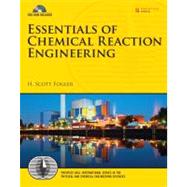
Note: Supplemental materials are not guaranteed with Rental or Used book purchases.
Purchase Benefits
H. Scott Fogler is the Ame and Catherine Vennema Professor of Chemical Engineering and the Arthur F. Thurnau Professor at the University of Michigan, and is the 2009 President of the American Institute of Chemical Engineers. His research interests include flow and reaction in porous media, fused chemical relations, gellation kinetics, colloidal phenomena, and catalyzed dissolution. He has been thesis advisor for 40 Ph.D. students and has more than 200 refereed publications in these areas. Fogler has chaired ASEE’s Chemical Engineering Division, served as director of the American Institute of Chemical Engineers, and earned the Warren K. Lewis Award from AIChE for contributions to chemical engineering education. He also received the Chemical Manufacturers Association’s National Catalyst Award. He is a coauthor of the best-selling textbook Strategies for Creative Problem Solving, Second Edition (Prentice Hall, 2008).
Preface xv
About the Author xxix
Chapter 1: Mole Balances 1
1.1 The Rate of Reaction, —rA 4
1.2 The General Mole Balance Equation 8
1.3 Batch Reactors (BRs) 10
1.4 Continuous-Flow Reactors 12
1.5 Industrial Reactors 22
Chapter 2: Conversion and Reactor Sizing 33
2.1 Definition of Conversion 34
2.2 Batch Reactor Design Equations 34
2.3 Design Equations for Flow Reactors 37
2.4 Sizing Continuous-Flow Reactors 40
2.5 Reactors in Series 49
2.6 Some Further Definitions 60
Chapter 3: Rate Laws 73
3.1 Basic Definitions 74
3.2 The Reaction Order and the Rate Law 76
3.3 The Reaction Rate Constant 86
3.4 Present Status of Our Approach to Reactor Sizing and Design 93
Chapter 4: Stoichiometry 105
4.1 Batch Systems 107
4.2 Flow Systems 113
Chapter 5: Isothermal Reactor Design: Conversion 139
5.1 Design Structure for Isothermal Reactors 140
5.2 Batch Reactors (BRs) 144
5.3 Continuous Stirred Tank Reactors (CSTRs) 152
5.4 Tubular Reactors 162
5.5 Pressure Drop in Reactors 169
5.6 Synthesizing the Design of a Chemical Plant 188
Chapter 6: Isothermal Reactor Design: Molar Flow Rates 207
6.1 The Molar Flow Rate Balance Algorithm 208
6.2 Mole Balances on CSTRs, PFRs, PBRs, and Batch Reactors 208
6.3 Applications of the Molar Flow Rate Algorithm to Microreactors 212
6.4 Membrane Reactors 217
6.5 Unsteady-State Operation of Stirred Reactors 225
6.6 Semibatch Reactors 226
Chapter 7: Collection and Analysis of Rate Data 245
7.1 The Algorithm for Data Analysis 246
7.2 Determining the Reaction Order for Each of Two Reactants Using the Method of Excess 248
7.3 Integral Method 249
7.4 Differential Method of Analysis 253
7.5 Nonlinear Regression 259
7.6 Reaction Rate Data from Differential Reactors 264
7.7 Experimental Planning 271
Chapter 8: Multiple Reactions 283
8.1 Definitions 283
8.2 Algorithm for Multiple Reactions 286
8.3 Parallel Reactions 289
8.4 Reactions in Series 298
8.5 Complex Reactions 308
8.6 Membrane Reactors to Improve Selectivity in Multiple Reactions 316
8.7 Sorting It All Out 321
8.8 The Fun Part 321
Chapter 9: Reaction Mechanisms, Pathways, Bioreactions, and Bioreactors 339
9.1 Active Intermediates and Nonelementary Rate Laws 340
9.2 Enzymatic Reaction Fundamentals 349
9.3 Inhibition of Enzyme Reactions 364
9.4 Bioreactors and Biosynthesis 371
Chapter 10: Catalysis and Catalytic Reactors 409
10.1 Catalysts 409
10.2 Steps in a Catalytic Reaction 415
10.3 Synthesizing a Rate Law, Mechanism, and Rate-Limiting Step 431
10.4 Heterogeneous Data Analysis for Reactor Design 446
10.5 Reaction Engineering in Microelectronic Fabrication 456
10.6 Model Discrimination 461
Chapter 11: Nonisothermal Reactor Design—The Steady State Energy Balance and Adiabatic PFR Applications 477
11.1 Rationale 478
11.2 The Energy Balance 479
11.3 The User Friendly Energy Balance Equations 486
11.4 Adiabatic Operation 492
11.5 Adiabatic Equilibrium Conversion and Reactor Staging 502
11.6 Optimum Feed Temperature 509
Chapter 12: Steady-State Nonisothermal Reactor Design–Flow Reactors with Heat Exchange 521
12.1 Steady-State Tubular Reactor with Heat Exchange 522
12.2 Balance on the Heat Transfer Fluid 525
12.3 Algorithm for PFR/PBR Design with Heat Effects 527
12.4 CSTR with Heat Effects 545
12.5 Multiple Steady States (MSS) 556
12.6 Nonisothermal Multiple Chemical Reactions 563
12.7 Safety 577
Chapter 13: Unsteady-State Nonisothermal Reactor Design 601
13.1 The Unsteady-State Energy Balance 602
13.2 Energy Balance on Batch Reactors 604
13.3 Semibatch Reactors with a Heat Exchanger 615
13.4 Unsteady Operation of a CSTR 620
13.5 Nonisothermal Multiple Reactions 624
Appendix A: Numerical Techniques 649
Appendix B: Ideal Gas Constant and Conversion Factors 655
Appendix C: Thermodynamic Relationships Involving the Equilibrium Constant 659
Appendix D: Nomenclature 665
Appendix E: Software Packages 669
E.1 Polymath 669
E.2 AspenTech 670
E.3 COMSOL 671
E.4 Software Packages 671
Appendix F: Rate Law Data 673
Appendix G: Open-Ended Problems 675
G.1 Design of Reaction Engineering Experiment 675
G.2 Effective Lubricant Design 675
G.3 Peach Bottom Nuclear Reactor 675
G.4 Underground Wet Oxidation 675
G.5 Hydrodesulfurization Reactor Design 676
G.6 Continuous Bioprocessing 676
G.7 Methanol Synthesis 676
G.8 Alcohol Metabolism 676
G.9 Methanol Poisoning 676
G.10 Cajun Seafood Gumbo 676
Appendix H: How to Use the DVD-ROM 679
H.1 DVD-ROM Components 679
H.2 How the DVD-ROM/Web Can Help Learning Styles 682
H.3 Navigation 683
Index 685
The New copy of this book will include any supplemental materials advertised. Please check the title of the book to determine if it should include any access cards, study guides, lab manuals, CDs, etc.
The Used, Rental and eBook copies of this book are not guaranteed to include any supplemental materials. Typically, only the book itself is included. This is true even if the title states it includes any access cards, study guides, lab manuals, CDs, etc.